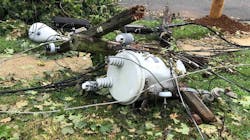NJBPU Issues Recommendations on Utilities' Responses to Isaias Power Outages
The New Jersey Board of Public Utilities (NJBPU) recently issued a comprehensive report on New Jersey's electric utilities' responses to power outages in the aftermath of Tropical Storm Isaias, which struck the state on Aug. 4 and disrupted utility service for more than 1.3 million utility customers, causing extended restoration times for many.
The NJBPU's Review and Assessment of Utility Performance report outlines recommendations for improvement in areas such as:
- Electric distribution company (EDC) communication and outreach with customers and public officials;
- Enhanced vegetation management in targeted areas;
- Tracking and valuing infrastructure hardening and resilience projects; and
- Reports and other metrics.
"Following every major weather event, there are always lessons we can learn and ways to further refine the preparations and response protocols for the next storm," said NJBPU President Joseph L. Fiordaliso. "This year, COVID-19 added an extra layer to utilities' response plans, forcing them to navigate an additional challenge as they repaired the damage from one of the most destructive storms our state has ever seen. We are seeing more frequent and more powerful storms resulting from climate change, and our top priority is to ensure ratepayers receive safe, reliable utility service. In reviewing the recovery from this particularly damaging weather incident, we identified specific, actionable recommendations for utilities to make our grid even stronger."
Tropical Storm Isaias brought intense winds and thousands of tree impacts that damaged New Jersey's overhead infrastructure. The report released contains a close analysis of the actions of each regulated EDC in New Jersey, before, during, and after Tropical Storm Isaias. The goals of this review were to evaluate the efficiency and effectiveness of utility restorations, to minimize the impacts of future storms, and to establish communication methods that provide more fluid communications between customers, elected officials, and utilities.
The NJBPU's review found that with the exception of Rockland Electric Co. (RECO), whose daily restoration progress and outage reduction was "out of sync" with the state's other EDCs, the overall rate of utility service restoration after Tropical Storm Isaias was reasonable, given the extent of damage.
The report includes recommendations for utilities to improve both communication and restoration times. These recommendations include but are not limited to:
- Updating the EDCs' outage management systems in order to improve handling of peak call center volume during major outage events, increase the accuracy of estimated time to repairs, and provide more reliable information to customers and public officials;
- Exploring solutions to expand the EDCs' ability to perform tree trimming and other vegetation management;
- Directing utilities to routinely evaluate the resiliency impact of storm hardening projects;
- Requiring the JCP&L to establish a process of communicating with elected officials and providing situational awareness about real-time restoration activity in its community; and
- Requiring the RECO to achieve an average daily restoration rate in New Jersey that is approximately equal to the average daily restoration rate for the New York territory during major events.
The report also addressed undergrounding, which is the process of burying power lines. Undergrounding is typically cost-prohibitive as a grid-wide solution, given that the approach costs 5 to 10 times more than overhead power lines. However, in the report, the NJBPU asked each utility to submit to the agency a cost-benefit analysis for five of their worst-performing circuits (or five circuits that use another metric) as candidates for undergrounding.
The report recognized that utilities have made significant improvements in storm preparedness and response since Hurricane Irene, Superstorm Sandy, and three nor’easters in 2018. In each of those cases, the board adopted dozens of improvement protocols. The board has also approved various utility plans for infrastructure improvements in the past few years. As a result, utilities' storm responses have improved over time, and replacement and hardening efforts will continue to create further resilience in the electric grid.
The board's review showed that following the storm, the EDCs mobilized more than 13,000 utility workers and support personnel in order to restore power to customers as quickly and safely as possible. Service was restored within 72 hours to more than 70% of utility customers affected by the storm. All affected customers were restored within a week, by Aug. 11.
Utilities have also been complying with COVID-19 health and safety protocols for all field operations and when participating in mutual assistance, which involves member utility companies pooling resources across regions, often in response to natural disasters. The recent report recognized that during the Isaias storm response, utilities faced unique challenges because of the pandemic, including restrictions on on-site person-to-person exchanges that commonly occur during a large-scale disaster. Overall, the NJBPU's analysis found that the utilities managed the COVID-19 aspect of the restoration process well.
The full report is available here.
